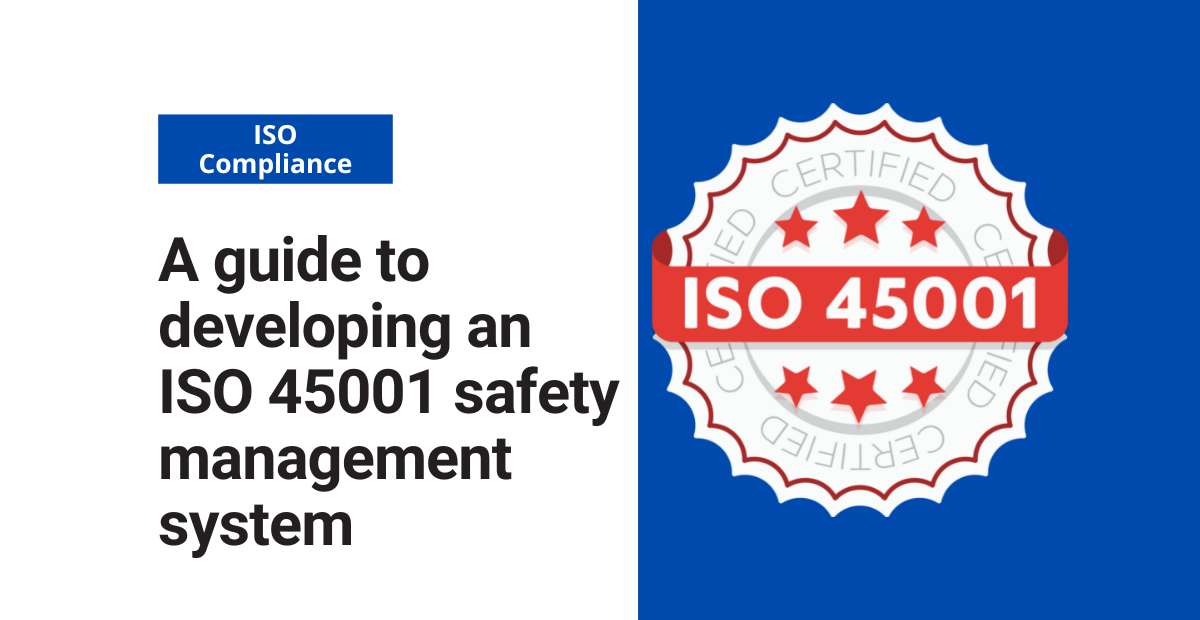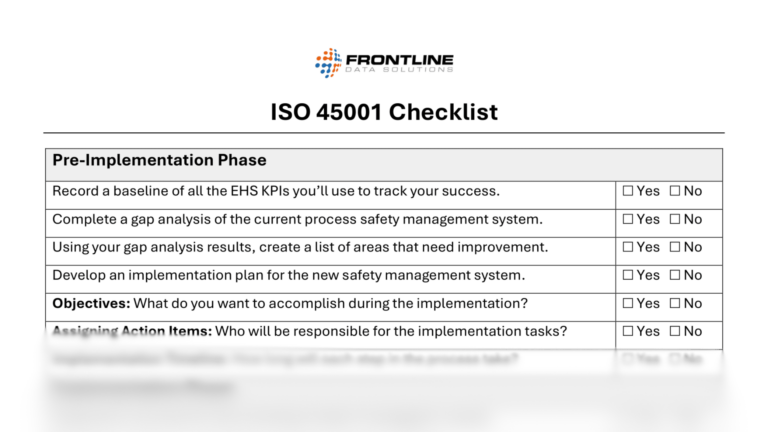ISO 45001 is an international standard for OH&S management systems. It provides a framework for organizations to proactively improve their OH&S performance. The goal is to reduce the risk of workplace injuries and illnesses.
Implementing ISO 45001 enables an organization to meet legal and regulatory OH&S requirements. By following the standard’s guidelines, organizations demonstrate their commitment to protecting employee health and safety. This proactive approach helps them avoid fines and penalties for non-compliance.
Free checklist!
This simple checklist includes the basic tasks you’ll need to complete when implementing the ISO 45001 framework.
ISO 45001 also helps improve an organization’s overall performance by reducing the number of workplace incidents and injuries. Lower costs associated with worker compensation, insurance, and lost productivity, improved reputation, and increased employee morale can also be expected.
Additionally, ISO 45001 is an internationally recognized standard. This means that an organization certified to the standard can demonstrate commitment to improving its OH&S performance. They can show this commitment to customers, suppliers, and other stakeholders. Through this safety management system, organizations gain a competitive advantage in the marketplace.
Implementing ISO 45001 safety management system
Developing and implementing the system typically involves the following steps:
- Perform a gap analysis to determine the current state of your organization’s safety management system. Identify any areas that need improvement.
- Develop a plan for implementing the new safety management system. This includes setting objectives, assigning responsibilities, and outlining a timeline for completion.
- Establish policies and procedures for managing safety within your organization. Include those related to risk assessment, incident investigation, and emergency response.
- Train employees on the new safety management system. Include any new policies and procedures. Ensure that they understand their roles and responsibilities.
- Implement the new safety management system and monitor its effectiveness through regular audits and inspections.
- Continuously improve the system by reviewing and updating policies and procedures, and taking corrective action as needed.
- Get certification by a certification body.
It’s important to note that the process should be tailored to the specific needs of your organization. Also, it should be a continuous process of improvement.
Pitfalls of ISO 45001 to consider
There are a few pitfalls that organizations should be aware of:
Lack of commitment
Achieving and maintaining certification requires a strong commitment from top management and all employees. Without this commitment, the standard may be viewed as just another compliance requirement and not fully embraced.
Limited focus on specific hazards
While ISO 45001 provides a comprehensive framework for OH&S management, it may not fully address specific hazards or risks. These are often unique to an organization or industry.
High costs
In reality, organizations incur significant costs when they implement and maintain an ISO management system, including expenses for training, documentation, and third-party audits.
Overreliance on the standard
It is a framework for OH&S management, but it should not be viewed as a substitute for a risk assessment or safety program. Above all, organizations must avoid relying solely on the standard to mitigate risks and protect their employees.
Difficulty in measuring and monitoring progress
Although ISO 45001 requires organizations to establish measurable objectives and targets for OH&S performance, many struggle to measure and monitor progress effectively.
Limited scope of certification
To start, ISO 45001 certification applies to a specific location and scope, such as a facility or a specific business unit. Consequently, it does not cover other locations or activities of the organization.
Overall, ISO 45001 lays a strong foundation for managing occupational health and safety. Therefore, organizations must identify potential pitfalls and actively take steps to correct them. Finally, they must perform proper risk assessments, deliver targeted training, and follow a clear plan for ongoing monitoring and continuous improvement.
Key KPIs for ISO 45001
As we previously mentioned, ISO 45001 requires organizations to establish measurable objectives and targets for OH&S performance. Some key performance indicators (KPIs) that organizations can use to measure and monitor their OH&S performance include:
Incident rates: Management should assess the number and rate of workplace injuries, illnesses, and fatalities.
Compliance with legal and regulatory requirements: The percentage of compliance with relevant OH&S laws and regulations is critical.
Employee engagement and participation: This refers to the percentage of employees who have received OH&S training. It also includes the number of employee suggestions for OH&S improvement and the number of employee-led OH&S initiatives.
OH&S management system effectiveness: This indicator includes the percentage of management system elements that are implemented and maintained. It also covers management system elements that are audited and found to be in compliance.
It’s important to remember that these are only examples of possible KPIs. Therefore, organizations should select the KPIs that align most closely with their unique OH&S risks and objectives.
In summary, ISO 45001 offers organizations an effective way to improve OH&S performance. It helps them comply with legal and regulatory requirements. Additionally, it reduces costs associated with workplace incidents. Finally, it allows organizations to demonstrate their commitment to safety to customers and other stakeholders.




